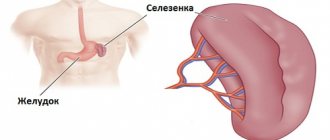What is mydriasis?
Pupil dilation, regardless of external or internal physiological reasons, is called mydriasis .
Know! For every person, in the absence of problems with the organs of vision, this state of the pupils is typical provided that the intensity of light around changes and both pupils enlarge simultaneously and evenly.
From an anatomical point of view, such changes in the pupil occur due to contraction of the ciliary and radial muscles, which are responsible for the constriction and dilation of the pupils, respectively.
When the muscle responsible for narrowing the pupil and maintaining such a stable state is disrupted, mydriasis is observed .
Additional causes of mydriasis
additional reasons for dilated pupils
For vision diagnostics
Separately, pupil dilation can be distinguished due to drug intervention and volitional control of pupil width. In the first case, medications are dripped into the eyes to examine the fundus. For these purposes, the drugs Atropine, Irifril, Midriacil are used. This condition is short-term and does not require therapy.
Sedatives
Enlarged pupils can occur with an overdose of sedatives (barbiturates) and long-term use of certain other medications. Spasm of accommodation is the reason for prescribing medications that relax the accommodative muscles. This therapy causes the pupil to dilate.
A person can enlarge the pupil of his own free will, but only for a very short period of time. This condition does not require therapy, is not dangerous and goes away very quickly. You can notice it only by carefully looking into the person’s eyes.
Classification of the disease
If such a disorder does not occur for physiological reasons , including exposure to light or a change in the emotional background, then mydriasis is considered pathological and can be classified depending on the causes of development as follows:
- Paralytic . Occurs as a result of injuries in which paralysis of the pupillary sphincter occurs.
- Medicinal . When using special drugs that affect the functioning of the sphincter of the eye and muscles, such expansion can occur. But it cannot be considered completely pathological, since mydriasis in this case is caused to facilitate examination of the visual organs. Almost always, after a few hours the pupil returns to normal without any outside intervention or treatment.
- Spastic . In this case, a spasm of the delitor muscle occurs, which dilates the pupil. This usually occurs due to an overdose of drugs containing adrenergic drugs.
- Traumatic . Such dilation of the pupil can be observed after damage to the muscles of the pupil due to a blow, household injury, or after surgery.
Keep in mind! Any type of mydriasis can always be characterized as unilateral or bilateral.
In the first case, the pupil dilates only in the left or right eye; in the second case, the disorder occurs in both eyes, while the pupil of one eye may dilate more.
Diagnostic procedure
Ophthalmoscopy under mydriasis
The procedure for performing ophthalmoscopy under mydriasis is not particularly difficult. As a rule, during the examination, it is enough for the patient to follow the instructions of the diagnostician and not overstrain the eyes. In general, the algorithm for examining the fundus of the eye looks like this:
- First, the diagnostician checks the patient’s appointment for the examination or studies his clinical picture himself, drawing conclusions about what type of ophthalmoscopy should be performed specifically in his case. Note that today either direct ophthalmoscopy or indirect (reverse) ophthalmoscopy is used. The first differs from the second only in that in its process the eyes are studied in more detail, which is why it is prescribed, as a rule, for already identified eye pathologies.
- After this, special drops called mydriatics are instilled into the patient’s eyes, which enlarge the pupil to its maximum size. Such a measure is necessary to obtain the most accurate indicators in the diagnostic process. This is due to the fact that the fundus of the eye is studied precisely by passing light rays through the pupil, as a result of which the rule applies - the wider it is, the more information about the organ can be obtained.
- And only then the diagnostics itself begins, which consists of using a special device - an ophthalmoscope. The diagnostician fixes it in the appropriate position together with the patient’s head and adjusts it for the examination. Based on the results of its implementation, the specialist creates a diagnostic sheet on which all existing eye pathologies or suspicions of them are noted.
It is worth noting that the procedure lasts about 5-15 minutes. The speed of diagnosis largely depends on the type of ophthalmoscope used and the severity of the patient’s eye health. The more modern the first and the weaker the second, the faster the ophthalmoscopy is performed. It's simple.
Reasons for development
Possible causes of mydriasis in humans may be:
- eye injuries. These are mainly blunt, non-penetrating injuries that do not lead to significant damage to the visual organs, but lead to eye contusion.
- compression or damage to the oculomotor nerves;
- diabetes mellitus and botulism . These are indirect reasons, the feast of which causes disturbances in the functioning of the visual organs and their structures.
- injuries to the skull and its base , which leads to damage to nerve endings;
- oxygen deficiency;
- neoplasms in the head . As they develop and increase, they compress either the midbrain, in which there are centers that constrict the pupil, or the muscles themselves, which change the size of the pupil;
- poisoning with barbituric acid derivatives and/or acetylcholinesterase inhibitors, which leads to intoxication;
- arterial aneurysmsaffecting the posterior communicating artery, located directly next to the nerve responsible for the movements of the eyeballs;
- any viral and infectious diseases that affect the intracranial and ocular nerve nodes.
For your information! The only neutral non-pathological reason is the use of medicinal mydriatic drugs before ophthalmological examinations.
In other cases, it is necessary to eliminate both the root cause of the symptom and stop the mydriasis itself.
Causes
Among the probable causes of the development of the described pathology:
- damage to the ciliary muscle due to cranial or ocular trauma;
- ophthalmological diseases;
- poisoning with drugs used as part of hormonal treatment;
- diseases of the nervous system;
- palsy of the optic nerve, which can be caused by increased intracranial pressure, tuberculosis, poisoning;
- brain oncology;
- diabetes;
- lack of oxygen.
A pathologically dilated pupil may be a consequence of the development of infections that provoke the death of nerve fibers. In addition, pathology can develop after eye surgery.
Symptoms
The dilation of the pupil itself and its increase to a size of more than 5 millimeters is the only symptom of mydriasis.
In some cases may develop such as impaired mobility of the eyeballs, deformation of the pupil , in which its shape becomes oval or pear-shaped, or lack of pupillary response to light .
Such symptoms occur with various diseases and injuries leading to mydriasis.
Why does the condition occur?
Under normal conditions, the size of the pupil ranges from 2–5 mm, and its condition is controlled by two main muscles:
- Constrictor pupil (sphincter).
- Pupil dilator (dilatator).
Their contraction occurs when certain nerve impulses arrive at them:
- The sphincter receives signals from the brain from the parasympathetic nervous system, acting on the muscle with acetylcholine.
- The dilator receives information from the cervical sympathetic trunk, located on either side of the spinal cord. In this case, the nerve fibers “send” molecules of adrenaline and norepinephrine to the muscle.
The transmission of signals to both muscles is in constant balance, so simultaneous constriction and dilation of the pupil cannot occur. When the dilator contracts or receives many signals, the pupil size becomes more than 5 mm, which leads to the development of mydriasis. This can be observed under physiological and pathological conditions.
There are unilateral (damage to the left or right eye) or bilateral (damage to both organs) mydriasis.
Physiological mydriasis
This form of pupil dilation is characterized by a normal, reflex reaction of the body to the influence of various external stimuli. This is most often observed in the following situations:
- Fear.
- Excitement.
- Painful sensations.
- Transition from light to dark lighting.
This type of mydriasis must be observed in both eyes and be symmetrical.
Dosage form
Drug dilation of the pupil develops when using the following drugs:
- Cholioblockers (Atropine, Tropicamide, Midriacil, etc.).
- Antihistamines (Diphenhydramine, Suprastin, Diazolin).
- Adrenergic agonists (Adrenaline, Noradrenaline, Mezaton, Naphthyzin, etc.)
A similar effect can develop when these products are instilled into the eyes or when used internally.
Ophthalmologists often use anticholinergic blockers to dilate the pupil to examine the fundus. The duration of mydriasis in this case depends on the specific drug.
Spastic appearance
It develops due to irritation and excitation of the sympathetic nervous system, resulting in increased release of adrenaline and norepinephrine by fibers that constantly act on the dilator of the pupil, causing its spasm and the inability of the muscle to relax. This form of mydriasis occurs for the following reasons:
- Lesions of the brain and spinal cord with syringomyelia, poliomyelitis, meningitis.
- Irritation of the cervical sympathetic trunk by an enlarged lymph node in pulmonary tuberculosis, focal formations in the upper lobe of the organ.
- Acute pancreatitis.
- Pleurisy.
- Stomach ulcer.
- Thyroid diseases.
In the spastic form, the constriction of the pupil during exposure to a light source persists.
Paralytic mydriasis
In this case, the sphincter is completely or partially disabled, but the dilator does not stop working, which is why the pupil remains dilated for a long time. This type of mydriasis occurs in the following diseases:
- Tuberculous meningitis and encephalitis.
- Neurosyphilis.
- Epilepsy.
- Parkinson's disease.
- Acute attack of glaucoma.
- Botulism.
- Carbon monoxide poisoning, cocaine, alcohol.
- Traumatic injury to the eye or after operations performed on it.
There is no reaction of the pupil to light and close distance in the paralytic form of mydriasis.
Mydriasis in Edie syndrome
The nerve fibers that send impulses to the sphincter of the pupil necessarily pass through the so-called 'ciliary ganglion' on their way. In some diseases (most often viral etiology), this formation is damaged, so narrowing of the organ is not possible.
For this reason, the patient’s pupil will be constricted in one eye, and dilated in the opposite eye. This condition is called anisocoria.
With this syndrome, the pupil's reaction to light, convergence (close distance) and accommodation will be absent. Patients also note photophobia and difficulties with visual work.
Diagnostics
Note! Diagnosis of such a pathological condition when the development of various diseases is suspected includes the following measures:
- drawing up a detailed medical history during a survey of the patient (and in some cases, a survey of his relatives);
- visual ophthalmological examination for the presence of injuries, ruptures and disruption of the integrity of the tissues of the eyeball;
- MRI and CT , which make it possible to identify more extensive and serious pathologies occurring in the brain tissue and potentially causing mydriasis;
- blood tests for the level of ESR, glucose and leukocytes (this way you can determine the presence of inflammatory processes in the body).
also possible to schedule an examination with a neurologist , who can identify the neurological cause of the pathology by assessing the shape and size of the pupils and their reaction to light.
Mydriasis in cats
A pathological condition during which cats have pupils of different sizes (mydriasis) is called anisocoria. This pathology can appear in a pet as a result of the appearance of:
- viral diseases;
- fungal diseases;
- when parasites appear;
- in the event of a bacterial disease;
- in case of injury and autoimmune diseases.
As a rule, mydriasis most often appears in cats as a result of diseases such as bartonellosis or toxoplasmosis. In some cases, the animal may develop pupils of different diameters due to the leukemia virus.
Attention!
Dilated pupils of the eyes (mydriasis) in a cat may appear against the background of the development of hypertensive retinopathy. This pathology occurs in the animal due to high blood pressure, which can provoke kidney disease.
When mydriasis appears in an animal, symptoms such as decreased visual acuity and level, the appearance of partial blindness, the appearance of cloudiness in the eye area, and the appearance of dilated pupils are observed. In some cases, due to the development of mydriasis, an animal may experience excessive hemorrhages inside the eyes.
Diagnosis of this pathology is carried out through a comprehensive ophthalmological examination of the animal. During such an examination, it is necessary to undergo an ultrasound of the eyes, fundoscopy, biomicroscopy, and ophthalmoscopy. In most cases, mydriasis in animals can be caused by the presence of various types of infectious diseases. Therefore, in this case, during diagnosis, it is recommended to conduct appropriate laboratory tests aimed at identifying diseases of an infectious or bacterial type.
Treatment of mydriasis in cats involves eliminating the underlying disease that caused the asymmetrical dilation of the pupils of the eyes. During the course of treatment, an effect is exerted on the animal’s body, during which all inflammatory processes in the vascular tract are eliminated.
Treatment
Elimination of mydriasis caused by instillation of special dilating drugs is not required in most cases.
Remember! If the pupils do not return to normal within a day or longer, it is possible to use drugs with a reverse effect - miotics (they narrow the pupil).
If the cause is pathological, then the specialist prescribes various medications based on the diagnosis, and for such mydriasis the following drugs can be used :
- pilocarpine hydrochloride, aceclidine (M-cholimimetics);
- hydrochloride, cytotin (N-cholimimetics);
- drugs in the nootropic category;
- vasoactive drugs or antiplatelet agents (to normalize blood circulation in the brain);
- anti-botulinum serum (for botulism);
- drugs that lower blood sugar levels (for diabetes);
- diuretics (for swelling in the brain area).
If the cause is the development of various tumors in the area of the visual organs or in the brain , drug therapy is inappropriate, and such pathology can be eliminated only by removing the tumors .
Treatment of mydriasis
There is no specific therapy for this pathology - treatment depends entirely on the etiological factor. The only exception is the physiological form of the disease, which goes away on its own without medical intervention.
In some cases, it is enough for patients to change their lifestyle, namely: give up bad habits, adequately use medications, in particular Atropine and Platifillin. Any drug must be prescribed by a clinician, and the duration of use and daily dosage must be strictly observed.
Drug therapy is selected in accordance with the underlying disease - patients can be prescribed:
- diuretics;
- nootropic substances;
- neurotrophics;
- antiplatelet agents;
- vasoactive substances;
- hypoglycemic drugs.
Surgical intervention can be performed if a post-traumatic type of illness has formed, as well as for the following indications:
- brain tumors;
- hematomas;
- vascular aneurysm;
- abscesses or cysts.
It is necessary to take into account that folk remedies will not help remove dilated pupils from the eyes, but, on the contrary, will only aggravate the problem.
Forecasts
For your information! With drug-induced mydriasis, in almost 100% of cases it goes away on its own. A less favorable, but generally good prognosis concerns mydriasis of a traumatic nature.
In such cases, such consequences can persist for weeks and months (sometimes up to four months).
In any case, pupil constriction can be provoked, regardless of the reasons, after eliminating the underlying disease.
To do this, it is enough to use the ophthalmic drug pilocarpine in low concentrations, but it must be used in the dosage prescribed by the doctor.












